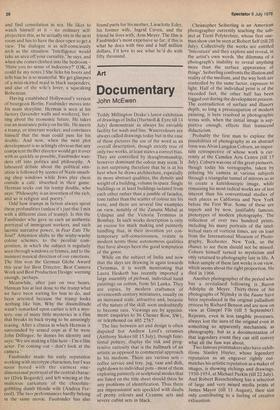Art
Documentary
John McEwen
Teddy Millington Drake's latest exhibition of drawings of India (Hartnoll & Eyre till 14 July) demonstrate as always his enviable facility for wash and line. Watercolours are always called drawings today but in the case of these pictures the use of the word as an overall description, though strictly true of only two works, at least states a correct bias. They are controlled by draughtsmanship, however dominant the colour may seem. It is not surprising therefore that he is at his best when he draws architecture, especially its more abstract qualities, the density and weight of a building, volume in space. Single buildings or at least buildings isolated from each other rather than a jumble of facades, tone rather than the scatter of colour are his forte, and there are several fine examples on view, notably of the Zanana Mahal at Udaipur and the Victoria Terminus in Bombay. In such works description is only an excuse for mark making and painterly handling that, in their invention yet contemporary self-consciousness, restate in modern terms those autonomous qualities that have always been the good temptation of the genre.
While on the subject of India and now that the days are drawing in again towards Christmas, it is worth mentioning that Laura Hesketh has recently imported a large assembly of pichwai, individual hand paintings on cotton, from Sri Lanka. They are copies, by modern craftsmen of seventeenth-century miniatures, usually on an increased scale, attractive and, because of the nature of the skill, soon undoubtedly to become rare. Viewings are by appointment: enquiries to 36 Chester Row, SW1, or telephoned on 405 2767.
The line between art and design is often disputed but Andrew Lord's ceramics (Anthony Stokes till 15 July), though functional pottery, display the risk and progressive curiosity that is the hallmark of an artistic as opposed to commercial approach to his medium. There are various sets — coffee service and tray, jug, vase and dish, right down to individual pots — most of them exploring painterly or sculptural modes that are listed on the title sheet should there be any problems of identification. Thus there are impressionist sets speckled with daubs of pretty colours and Cezanne sets and severe cubist sets in black. Christopher Seiberling is an American photographer currently teaching the subject at Trent Polytechnic, whose first oneman show can be seen at Robert Self (till 20 July). Collectively the works are entitled 'Interstices' and they explore and reveal, in the artist's own words 'the dilemma of a photograph's inability to reveal anything more than the surface appearance of things'. Seiberling confronts the illusion and reality of the medium, and the way both are controlled by the same factor, exposure to light. Half of the individual print is of the recorded fact, the other half has been fogged out during the development process. The contradiction of surface and illusory depth, so long a preoccupation of modern painting, is here resolved in photographic terms with, when the initial image is supportive enough, effects that transcend didacticism.
Probably the first man to explore the possibilities of photography as an abstract form was Alvin Langdon Coburn, an important retrospective of whose work is currently at the Camden Arts Centre (till 15 July). Coburn was one of the great pioneers, though today his vortographs, taken by pointing his camera at various subjects through a triangular tunnel of mirrors so as to create a kaleidoscopic image, while remaining his most radical works are of less interest than his conventional studies of such places as California and New York before the First War. Some of these are superb and by now, justifiably famous, prototypes of modern photography. The collection of over two hundred prints, including his many portraits of the intellectual stars of vorticist times, are on loan from the International Museum of Photography, Rochester, New York, so the chance to see them should not be missed. Coburn himself turned to mysticism and only returned to photography late in life. A token sample of these last works is on view, which seems about the right proportion. He died in 1966.
Another photographer of the period who has a revitalised following is Baron Adolphe de Meyer. Thirty-three of his photographs of Nijinsky in the Faune have been reproduced in the original palladium process by Richard Benson and are now on view at Gimpel Fils (till 5 September). Reprints, even in less tangible processes, always lost the aura of the original even in something so apparently mechanistic as photography, but as a documentation of that legendary event they can still convey what all the fuss was about.
Two famous printmakers also have exhibitions. Stanley Hayter, whose legendary reputation as an engraver rightly outmatches his artistic reputation as a maker of images, is showing etchings and drawings, 1930-1954, at Michael Parkin (till 22 July). And Robert Rauschenberg has a selection of large and very mixed media prints at James Mayor (till 11 August), their size only contributing to a feeling of creative exhaustion.


































 Previous page
Previous page